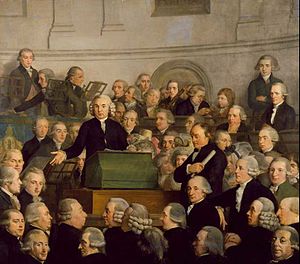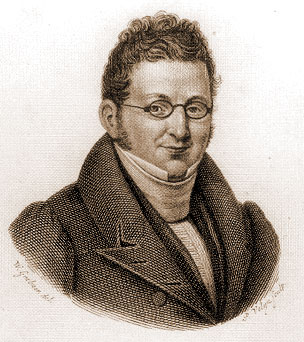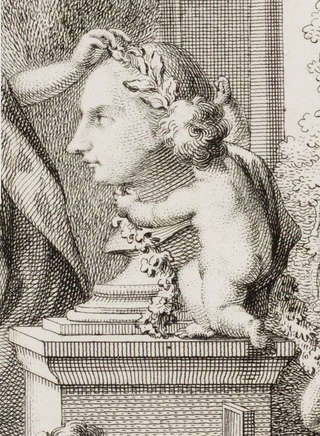
Felix Meritis ("Happy through Merit") is the name of an intellectual society in Amsterdam, but subsequently used for the building they built for themselves [1] on the Keizersgracht.

Felix Meritis ("Happy through Merit") is the name of an intellectual society in Amsterdam, but subsequently used for the building they built for themselves [1] on the Keizersgracht.


It was built according to a winning design by the architect Jacob Otten Husly for the new society called Felix Meritis established in 1776 for Music, Drawing, Physics, Commerce and Literature in the modern neo-classical style. Husly had won a similar design contest for the city hall of Groningen in the previous year. [3] The building itself was meant to exemplify the Enlightenment ideals the society stood for. The classical temple façade with its colossal Corinthian pilasters and pediment represent the society's five departments with five sculptures representing the visual arts and architecture, literature, trade, natural sciences and music. The interior includes original 18th-century features such as the central staircase, the oval concert hall (renowned for its acoustics) and the domed roof - underneath which there used to be an astronomical observatory.
On 31 October 1788 the building of the same name opened its doors. The society focused on the promotion of arts and sciences in a broader sense than the artists collectives popular at the time. Husly was himself a board member of the Amsterdam city drawing academy Stadstekenacademie , that had close contacts with the Oeconomischen Tak van de Hollandsche Maatschappij der Wetenschappen (economics branch of the Hollandsche Maatschappij der Wetenschappen, which met in the Trippenhuis). The society was abolished in 1888.
Felix Meritis’ oval concert hall was the main music hall in Amsterdam until late into the 19th century and enjoyed a great international reputation. Many famous musicians performed there, including Robert and Clara Schumann, Camille Saint-Saëns, Johannes Brahms and Julius Röntgen. The orchestra of Felix Meritis was regarded as the best of the Netherlands and accompanied many Dutch premieres, directed by conductors such as Johannes Bernardus van Bree. Thus, Beethoven’s Ninth Symphony and Berlioz’s Symphonie fantastique had their Dutch premiere in the concert hall of Felix Meritis. The small hall of the Concertgebouw is a replica of this concert hall.

When the old Felix Meritis society was dissolved in 1888, the printing company Holdert & Co., which became one of Amsterdam's largest printing companies, moved into the building. In 1932 part of the building was destroyed in a fire. After the Second World War the Communist Party of the Netherlands set up its headquarters in the building. From 1947 until 1981 its newspaper 'De Waarheid' ('The Truth') rolled from the presses. In the 50s, Felix Meritis became the symbol of communism in the Netherlands. This image became especially embedded in the collective memory when the building was stormed on 4 November 1956, in response to the Soviet invasion of Hungary and its endorsement by the Dutch communist party. However, in the late sixties, Felix Meritis became a cradle of evenings for alternative youth, which were named Provadya. In 1969 the Shaffy Theater opened, which gained a reputation as a stopping place for the Dutch avant-garde, including Ramses Shaffy, Baal, Neerlands Hoop, Independent Theater and Hauser Orkater.
In 1988, one hundred years after the old society was dissolved, The Felix Meritis foundation was re-established in the building as a European center for art, culture and science. Felix Meritis is an independent international meeting place and serves as director of the European public debate, cultural processes and international projects and exchanges. Felix Meritis presents itself as a knowledge institution and platform for European cultural dialogue and cultural-political issues. The motto of Felix Meritis is Connecting Cultures. In collaboration with partners from home and abroad Felix Meritis initiates projects such as A Soul for Europe, Amsterdam Forum, The People Network, Gulliver Connect, Amsterdam Summer University, Dare2Connect, The European House for Culture (Brussels), Night of Philosophy, Cafe Europa, The Globalization Lecture Foundation and Kuhnya.
In November 2014, the management company Amerborgh, owned by Alex Mulder, purchased Felix Meritis from the city of Amsterdam. Amerborgh started renovating the building in 2017. Between 2015 and 2016 the building housed the temporary project “Felix in de Steigers,” providing space for art, theater and several experimental cultural programs while construction was under way.

The Royal Netherlands Academy of Arts and Sciences is an organization dedicated to the advancement of science and literature in the Netherlands. The academy is housed in the Trippenhuis in Amsterdam.

Martin(us) van Marum was a Dutch physician, inventor, scientist and teacher, who studied medicine and philosophy in Groningen. Van Marum introduced modern chemistry in the Netherlands after the theories of Lavoisier, and several scientific applications for general use. He became famous for his demonstrations with instruments, most notable the Large electricity machine, to show statical electricity and chemical experiments while curator for the Teylers Museum.

Corneli(u)s Rudolphus Theodorus, Baron Krayenhoff was a physicist, artist, general, hydraulic engineer, cartographer and – against his will and for only a short time – Dutch Minister of War.
Royal BAM Group nv is a Dutch construction-services business with headquarters in Bunnik, Netherlands. It is the largest construction company based on revenue in the Netherlands.

Pieter Teyler van der Hulst was a wealthy Dutch Mennonite merchant and banker, who died childless, leaving a legacy of two million florins to the pursuit of religion, arts and science in his hometown, that led to the formation of Teyler's Museum. This was not the value of his entire estate. He also founded Teylers Hofje in his name, and made important donations to individuals in the Mennonite community.

Christianus Petrus Eliza Robidé van der Aa was a Dutch jurist and author. He was the son of Pierre Jean Baptiste Charles van der Aa.

The Hollandsche Manege in Amsterdam is the oldest riding school in the Netherlands, dating back to 1744. The current building, inspired by the Spanish Riding School in Vienna, was constructed in 1882.

Henricus Aeneae was a Dutch scientist and mathematician.

De Negen Straatjes is a neighbourhood of Amsterdam, Netherlands located in the Grachtengordel, a UNESCO World Heritage Site.

The Koninklijke Hollandsche Maatschappij der Wetenschappen, located on the east side of the Spaarne in downtown Haarlem, Netherlands, was established in 1752 and is the oldest society for the sciences in the country. The society has been housed in its present location, called Hodshon Huis, since 1841. Nearby the society is the Teylers Museum, a closely related museum of natural history founded in 1784. In 2002, the society was awarded the predicate "Royal" when it celebrated 250 years of science studies.

Cornelius Nozeman or Cornelis was a Dutch Remonstrant churchman and naturalist.

Jacob Otten Husly was an 18th-century architect from the Northern Netherlands.

The Royal Theater Carré is a Neo-Renaissance theatre in Amsterdam, located near the river Amstel. When the theatre was founded in 1887, it was originally meant as a permanent circus building. Currently, it is mainly used for musicals, cabaret performances and pop concerts. Carré is located next to the Amstel, close to Waterlooplein. Its address is Amstel 115 and has approximately 1,700 seats.
Georg Adam Joseph Schmitt was a German/Dutch composer, conductor, music director, publisher, music theorist and pedagogue. He is also known as "The Dutch Haydn".
The following is a timeline of the history of the municipality of Amsterdam, Netherlands.

The Maatschappij der Nederlandse Letterkunde is a prestigious and exclusive literary society. The MNL was established in Leiden in 1766 and is still located there. At the moment, the society has approximately 1,600 members, mainly Dutch scholars. New members can only be elected after they are introduced by existing members. The MNL has two regional branches, for the Northern and the Southern part of the Netherlands, and also a representative in South Africa. King Willem-Alexander is the patron of the MNL.
The following is a timeline of the history of the municipality of Leiden, Netherlands.
Gerard Isaäc Lieftinck, known in print as G.I. Lieftinck, was a Dutch academic specialising in medieval European manuscripts.
Sonia Kéfi is a network scientist and systems ecologist who studies ecosystem dynamics and the resilience of ecosystems to climate change and human land use. She works for the French National Centre for Scientific Research (CNRS) in the Institut des Sciences de l’Evolution de Montpellier, associated with the University of Montpellier, and is also affiliated as an external professor with the Santa Fe Institute.

Franz "Frans" Marius Theodor de Liagre Böhl was a Dutch professor of Assyriology and Hebrew.